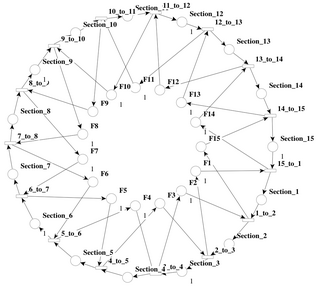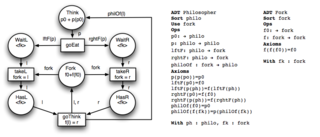
In computer science, concurrency is the ability of different parts or units of a program, algorithm, or problem to be executed out-of-order or in partial order, without affecting the final outcome. This allows for parallel execution of the concurrent units, which can significantly improve overall speed of the execution in multi-processor and multi-core systems. In more technical terms, concurrency refers to the decomposability property of a program, algorithm, or problem into order-independent or partially-ordered components or units.

Sequential function chart (SFC) is a graphical programming language used for programmable logic controllers (PLCs). It is one of the five languages defined by IEC 61131-3 standard. The SFC standard is defined as, Preparation of function charts for control systems, and was based on GRAFCET.
Coloured Petri nets (CPN) are a backward compatible extension of the concept of Petri nets.

PetriScript is a modeling language for Petri nets, designed by Alexandre Hamez and Xavier Renault. The CPN-AMI platform provides many tools to work on Petri nets, such as verifying and model-checking tools.
YAWL is a workflow language based on workflow patterns. The language is supported by a software system that includes an execution engine, a graphical editor and a worklist handler. The system is available as Open source software under the LGPL license.
A control register is a processor register which changes or controls the general behavior of a CPU or other digital device. Common tasks performed by control registers include interrupt control, switching the addressing mode, paging control, and coprocessor control.
A marked graph is a Petri net in which every place has exactly one incoming arc, and exactly one outgoing arc. This means, that there can not be conflict, but there can be concurrency. Mathematically: . Marked graphs are used mostly to mathematically represent concurrently running operations, such as a multiprocessor machine's internal process state. This class of Petri nets gets the name from a popular way of representing them: as a graph where each place is an edge and each transition is a node.
Krassimir Todorov Atanassov is a Bulgarian mathematician, Corresponding member of the Bulgarian Academy of Sciences (2012). He is best known for introducing the concepts of Generalized nets and Intuitionistic fuzzy sets, which are extensions of the concepts of Petri nets and Fuzzy sets, respectively.
Dualistic Petri nets (dPNs) are a process-class variant of Petri nets. Like Petri nets in general and many related formalisms and notations, they are used to describe and analyze process architecture.
Well-formed Petri nets are a Petri net class jointly elaborated between the University of Paris 6 and the University of Torino in the early 1990s.
Enterprise engineering is defined as the body of knowledge, principles, and practices to design all or part of an enterprise. An enterprise is a complex, socio-technical system that comprises interdependent resources of people, information, and technology that must interact with each other and their environment in support of a common mission. According to Kosanke, Vernadat and Zelm, enterprise engineering is an enterprise life-cycle oriented discipline for the identification, design, and implementation of enterprises and their continuous evolution, supported by enterprise modelling. Enterprise engineering is a subdiscipline of industrial engineering / systems engineering. The discipline examines each aspect of the enterprise, including business processes, information flows, material flows, and organizational structure. Enterprise engineering may focus on the design of the enterprise as a whole, or on the design and integration of certain business components.
Process architecture is the structural design of general process systems. It applies to fields such as computers, business processes, and any other process system of varying degrees of complexity.
An amateur radio net, or simply ham net, is an "on-the-air" gathering of amateur radio operators. Most nets convene on a regular schedule and specific frequency, and are organized for a particular purpose, such as relaying messages, discussing a common topic of interest, in severe weather, emergencies, or simply as a regular gathering of friends for conversation.

An algebraic Petri net (APN) is an evolution of the well known Petri net in which elements of user defined data types replace black tokens. This formalism can be compared to coloured Petri nets (CPN) in many aspects. However, in the APN case, the semantics of the data types is given by an axiomatization enabling proofs and computations on it.
The Theory of regions is an approach for synthesizing a Petri net from a transition system. As such, it aims at recovering concurrent, independent behaviour from transitions between global states. Theory of regions handles elementary net systems as well as P/T nets and other kinds of nets. An important point is that the approach is aimed at the synthesis of unlabeled Petri nets only.

TAPAAL is a tool for modelling, simulation and verification of Timed-Arc Petri nets developed at Department of Computer Science at Aalborg University in Denmark and it is available for Linux, Windows and Mac OS X platforms.
Stochastic Petri nets are a form of Petri net where the transitions fire after a probabilistic delay determined by a random variable.
Nets within Nets is a modelling method belonging to the family of Petri nets. This method is distinguished from other sorts of Petri nets by the possibility to provide their tokens with a proper structure, which is based on Petri net modelling again. Hence, a net can contain further net items, being able to move around and fire themselves.
Petri net (PN) slicing is a syntactic technique used to reduce a PN model based on a given criterion. Informally, a slicing criterion could be a property for which a PN model is analyzed or is a set of places, transitions, or both. A sliced part constitutes only that part of a PN model that may affect the criteria.





